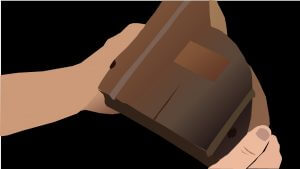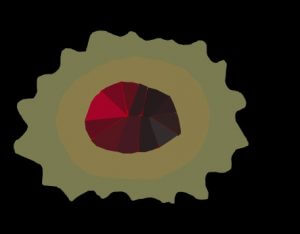The Curse of Oak Island- Season 5, Episode 16: Seeing Red
The following is a Plot Summary and Analysis of Season 5, Episode 16 of the History Channel’s TV series The Curse of Oak Island.
.
.
[SPOILER ALERT!!!]
.
.
Plot Summary
This episode begins in the War Room. There, members of the Oak Island team reaffirm their desire to send diver Mike Huntley to the bottom of the DMT Shaft in order to determine the nature of the obstruction there, which has prevented the treasure hunters from excavating the shaft beyond a depth of 77 feet. The phone up Huntley, inform him of their predicament, and secure his assistance.
 While the crew members of Irving Equipment Ltd. go about disassembling their excavation equipment in order to prepare for Huntley’s upcoming dive, Rick and Marty Lagina, Dave Blankenship, Charles Barkhouse, and Gary Drayton head to Smith’s Cove. There, while the tide is still low, they use a backhoe to dig a hole at the spot where Rick and Gary discovered the lead cross in Season 5, Episode 10. Meanwhile, Gary uses a metal detector for search for anything of interest in the hole and its spoils.
While the crew members of Irving Equipment Ltd. go about disassembling their excavation equipment in order to prepare for Huntley’s upcoming dive, Rick and Marty Lagina, Dave Blankenship, Charles Barkhouse, and Gary Drayton head to Smith’s Cove. There, while the tide is still low, they use a backhoe to dig a hole at the spot where Rick and Gary discovered the lead cross in Season 5, Episode 10. Meanwhile, Gary uses a metal detector for search for anything of interest in the hole and its spoils.
After digging for some time, the crew uncovers what appears to be the remains of an old wooden structure which, the narrator suggests, is somewhat reminiscent of the suspected French drain found in the area in Season 4, Episode 15. As they haul up a large piece of wood, the treasure hunters ponder the possibility that they might have discovered remains of the “U-shaped structure” which Dan Blankenship and members of Triton Alliance discovered in 1971. Shortly after making the discovery, the treasure hunters are forced to abandon the dig site on account of the rising tide level. They agree that they ought to carbon date the piece of wood they managed to extract, and to conduct a more rigorous excavation at Smith’s Cove if the wood proves to pre-date the 1795 discovery of the Money Pit.

Later that day, Rick Lagina and Charles Barkhouse pay a visit to Dan Blankenship. In Dan’s kitchen, Rick and Charles ask the elder treasure hunter about his discovery of the U-shaped structure in Smith’s Cove. Blankenship explains that the “structure” was not a wall, with one log piled atop another, but rather a chain of notched logs, and that he and the men of Triton Alliance left it where they had found it. Regarding his opinion on the structure’s nature, he says, “I never did come up with a definitive answer,” although maintains he did believe the structure constituted original workings when he and his fellow treasure hunters first discovered it.

Later, Rick Lagina, Dave Blankenship, and Charles Barkhouse travel to Wolfville, Nova Scotia. There, they meet with Troy Coldwell, Kathleen Bishop, and Lynn Hiltz- all of them descendants of a man named Harold Bishop, who worked as a crane operator for Oak Island treasure hunter Robert Dunfield in the mid-late 1960’s. The relatives show the treasure hunters a piece of timber which Harold Bishop unearthed from the Money Pit area during Dunfield’s heavy duty excavation. The timber fragment bears a brass plaque which reads, “Found by Harold Bishop at Oak Island 1965.” Troy, Kathleen, and Lynn explain that Harold Bishop believed that the artifact “perhaps might have been part of a ship,” evoking Fred Nolan’s theory that a ship was buried in the swamp, as well as the log of a French ship which Doug Crowell introduced in Season 5, Episode 10. Dave Blankenship, observing that the piece bears two parallel, rectangular grooves, elaborates on that theory by suggesting that the piece might have been part of a ship’s rudder. The three relatives then point out two square nails embedded in the wood. When asked by the treasure hunters, the relatives agree to submit the artifact for testing.
 Three days later, Rick Lagina, Dave Blankenship, and Charles Barkhouse meet in the War Room with geophysical engineer John Wonnacott, a veteran Oak Island researcher. The narrator explains that Wonnacott “conducted a previous investigation into the possible origins of the U-shaped structure” on behalf of Dan Blankenship. The four men initiate a video conference with Marty Lagina and Craig Tester, who inform them that the piece of timber unearthed on Smith’s Cove was carbon dated from 1684-1732, while the piece of wood discovered by Harold Bishop was carbon dated from 1646-1690. Marty remarks that these dates correspond closely with those of the human bones brought up from Drillhole H8. The treasure hunters agree that, in light of this new information, they ought to build a cofferdam around Smith’s Cove and conduct a more thorough excavation there in order to fully expose, and subsequently study, the U-shaped structure.
Three days later, Rick Lagina, Dave Blankenship, and Charles Barkhouse meet in the War Room with geophysical engineer John Wonnacott, a veteran Oak Island researcher. The narrator explains that Wonnacott “conducted a previous investigation into the possible origins of the U-shaped structure” on behalf of Dan Blankenship. The four men initiate a video conference with Marty Lagina and Craig Tester, who inform them that the piece of timber unearthed on Smith’s Cove was carbon dated from 1684-1732, while the piece of wood discovered by Harold Bishop was carbon dated from 1646-1690. Marty remarks that these dates correspond closely with those of the human bones brought up from Drillhole H8. The treasure hunters agree that, in light of this new information, they ought to build a cofferdam around Smith’s Cove and conduct a more thorough excavation there in order to fully expose, and subsequently study, the U-shaped structure.

Later, Rick Lagina and Gary Drayton go on a metal detecting excursion on Oak Island’s Lot 8. Drayton quickly uncovers an old military button. Shortly thereafter, he unearths a metal brooch which appears to be missing its centrepiece. Drayton suggests that he and Rick leave the hole from which they extracted the artifact unfilled so that they might later sift through the dirt beneath it and hopefully recover the missing piece. While waving his instrument over the hole one last time, Drayton’s metal detector gets a faint hint. Upon closer inspection, the treasure hunter discovers the source of the hit to be a red jewel ensconced in a metal ring- almost certainly the brooch’s missing centrepiece. “Yeah, that’s old,” says Drayton. “That’s 1700’s. And remember, Rick, back in the day, they did things properly.” The narrator follows up on Drayton’s implication that the gemstone might be a genuine ruby by remarking that the find is consistent with the Oak Island theory regarding Marie Antoinette’s jewels.
Rick and Gary inform their fellow treasure hunters of their find via radio, and are soon joined by the rest of the team. The treasure hunters congratulate Drayton on his discovery and agree that they ought to submit the jewel to a jeweler for analysis.
Analysis
U-Shaped Structure
 In the summer of 1970, Triton Alliance built a 400-foot-long cofferdam around the perimeter of Smith’s Cove. Upon its construction, Dan Blankenship discovered a large U-shaped wooden structure below the low tide line. This structure was made of 30-65-foot logs which were notched at 4-foot intervals. Each notch was labelled with a Roman numeral, and it appeared as if each notch had been fitted with a wooden dowel. Most experts who analyzed the structure determined that it was likely an ancient wharf or the remnants of a cofferdam constructed by the original workers.
In the summer of 1970, Triton Alliance built a 400-foot-long cofferdam around the perimeter of Smith’s Cove. Upon its construction, Dan Blankenship discovered a large U-shaped wooden structure below the low tide line. This structure was made of 30-65-foot logs which were notched at 4-foot intervals. Each notch was labelled with a Roman numeral, and it appeared as if each notch had been fitted with a wooden dowel. Most experts who analyzed the structure determined that it was likely an ancient wharf or the remnants of a cofferdam constructed by the original workers.
One alternative theory regarding the nature of this U-shaped structure was put forth by Canadian author Joy A. Steele in her 2015 book Oak Island Mystery Solved. Steele argued that Oak Island served not as a treasure depository, but rather as the headquarters of a British tar-manufacturing enterprise, and that the U-shaped structure constituted a brace designed to keep tar kilns in place.
According to geophysical engineer John Wonnacott, who appears in this episode, in an article on OakIslandCompendium.com, he, David Tobias (Dan Blankenship’s business partner), and Les MacPhie (a fellow engineer) unearthed a section of the U-shaped structure in the year 2000 and submitted a piece of it for analysis. Disappointingly, the wood was carbon dated to 1860, plus or minus thirty years- a date consistent with cofferdams built by the Truro Company in 1850, and by the Halifax Company in 1866.
In 2015, after observing the results of some of Oak Island Tours Inc.’s carbon dating analyses, Wonnacott had the piece of wood he dug up in 2000 examined by a dendrochronologist- an expert in tree-ring dating. In a follow-up article, he revealed that the dendrochronologist determined that the tree which yielded the wood sample sprouted and was felled, respectively, on two of six different dates: 1659 and 1695; 1711 and 1745; or 1822 and 1858. The first two possible date combinations correspond with a number of Oak Island theories, while the third vaguely suggests the 1866 Halifax Company cofferdam.
Want to Help?
If you enjoyed this article and would like to help support this website, please check out our online bookshop:







Leave a Reply